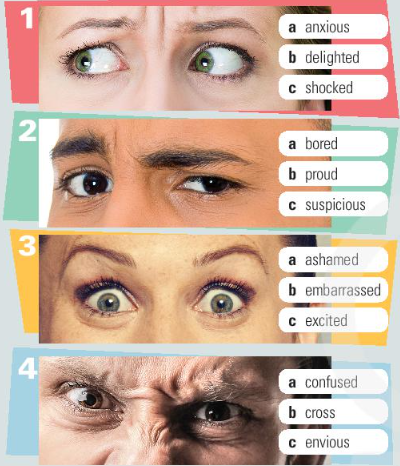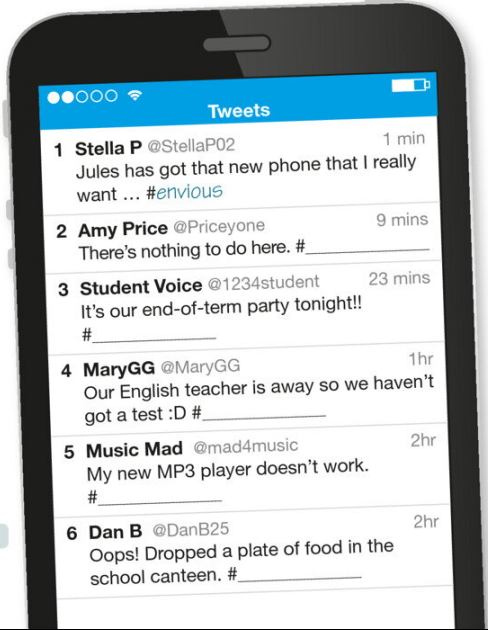Tiếng Anh 10 Unit 1 1A. Vocabulary1. SPEAKING Look at the photos and answer the questions. 2. VOCABULARY Check the meaning of all the adjectives below. Can you match any of them with the photos in exercise 1? 3. Work in pairs. Put the adjectives in exercise 2 into categories A and B below. Do you know any other adjectives you could add to the categories? 4. PRONUNCIATION Listen and repeat. Pay attention to the ending sounds. Say the words. Decide if the endings are pronounced /id/, /d/ or /t/. Listen again and check. Tổng hợp đề thi học kì 1 lớp 10 tất cả các môn - Chân trời sáng tạo Toán - Văn - Anh - Lí - Hóa - Sinh - Sử - Địa... Quảng cáo
Lựa chọn câu để xem lời giải nhanh hơn
Bài 1 1. SPEAKING Look at the photos and answer the questions. (Nhìn vào các bức ảnh và trả lời câu hỏi.)
1. How do you think these people are feeling? (Bạn nghĩ những người này đang cảm thấy thế nào?) 2. What is making them feel that way? (Điều gì đang khiến họ cảm thấy như vậy?) Lời giải chi tiết: 1. A. worried (lo lắng), B. happy (vui vẻ), excited (hào hứng). 2. Photo A: The man is worried because the people are standing too close to each other and they are not wearing masks. (Ảnh A: Người đàn ông lo lắng vì mọi người đứng quá gần nhau và họ không đeo khẩu trang.) Photo B: The girls are happy because it is their graduation day. (Ảnh B: Các cô gái rất vui vì đây là ngày tốt nghiệp của họ.) Photo C: The girl's schoolwork is difficult and boring. (Ảnh C: Bài tập ở trường của cô gái thật khó khăn và nhàm chán.) Bài 2 2. VOCABULARY Check the meaning of all the adjectives below. Can you match any of them with the photos in exercise 1? (Tra nghĩa của các tính từ bên dưới. Liệu bạn có thể nối tính từ nào vào các bức ảnh của Bài 1 không?) Adjectives to describe feelings anxious ashamed bored confused cross delighted disappointed embarrassed envious excited frightened proud relieved shocked suspicious upset Lời giải chi tiết:
The man in photo A look anxious/ upset. (Người đàn ông trong ảnh A có vẻ lo lắng / buồn bã.) The people in photo B look delighted/ excited/ proud. (Những người trong bức ảnh B trông rất vui mừng / phấn khích / tự hào.) The girl in photo C looks bored. (Cô gái trong ảnh C có vẻ chán nản.) Bài 3 3. Work in pairs. Put the adjectives in exercise 2 into categories A and B below. Do you know any other adjectives you could add to the categories? (Làm việc theo cặp. Xếp các tính từ trong bài 2 vào các cột A và B bên dưới. Bạn có biết những tính từ nào khác có thể thêm vào các cột không?)
Lời giải chi tiết:
Bài 4 4. PRONUNCIATION Listen and repeat. Pay attention to the ending sounds. (Nghe và lặp lại, chú ý âm cuối.) shame bore confuse delight embarrass excite frighten relieve shock Say the words. Decide if the endings are pronounced /id/, /d/ or /t/. Listen again and check. (Đọc các từ. Xem các âm đuôi được phát âm là /id/, /d/ or /t/. Nghe và kiểm tra.) shamed bored confused delighted embarrassed excited frightened relieved shocked Lời giải chi tiết:
Bài 5 5. In pairs, do the quiz below. How many did you get right? (Làm bài đố vui bên dưới theo cặp. Bạn đúng được bao nhiêu câu?) Can you read people's emotions? (Bạn có thể đọc cảm xúc của mọi người không?) For each photo, choose the adjective (a - c) that matches how the person is feeling. (Với mỗi bức ảnh, chọn tính từ (a-c) thích hợp với cảm xúc của mỗi người.)
Lời giải chi tiết:
1. a. anxious (lo lắng) b. delighted (hài lòng) c. shocked (sốc) 2. a. bored (chán) b. proud (tự hào) c. suspicious (hoài nghi) 3. a. ashamed (ngại ngùng) b. embarrassed (lúng túng) c. excited (hào hứng) 4. a. confused (bối rối) b. cross (tức giận) c. envious (ghen tị) Bài 6 6. Read the tweets and complete the hashtags with adjectives from exercise 2. (Đọc các tweets và hoàn thành các hastags với các tính từ từ Bài 2.)
Lời giải chi tiết:
(1) Jules has got that new phone that I really want… #envious (Jules có chiếc điện thoại mới mà tôi rất muốn… #ghen_tị) (2) There’s nothing to do here. #bored (Không có gì làm ở đây cả. #chán) (3) It’s our end-of-term party tonight!! #excited/ relieved (Đây là tiệc kết thúc kì học vào tối nay của chúng tôi!! #thích thú / nhẹ nhõm) (4) Our English teacher is away so we haven’t got a test. :D #delighted/ relieved (Giáo viên Tiếng anh của chúng tôi đi vắng rồi nên chúng tôi không có bài kiểm tra. #vui mừng/ nhẹ nhõm) (5) My new MP3 player doesn't work. #disappointed (Máy MP3 mới của tôi bị hỏng. # thất vọng) (6) Oops! Dropped a plate of food in the school canteen. #embarrassed (Oops! Lỡ làm đổ đĩa đồ ăn trong căn tin trường. # bối rối) Bài 7 7. Listen to four speakers. Match one adjective from the list below with each speaker (1-4). There are four extra adjectives. (Nghe bốn người nói. Nối một tính từ trong danh sách bên dưới với mỗi người nói (1-4). Có bốn tính từ thừa.)
Phương pháp giải: Bài nghe: 1. Guess what? You know there's a big charity concert at Wembley Stadium next week? Well, I've got a ticket! ...I know! It's great, isn't it? ... Who's playing? Loads of bands.... Well, for a start, the Black Eyed Peas.... I know! And Lady Gaga. And Katy Perry.... I know, amazing! I can't wait! 2. Hi. What are you up to?... Oh, really? Sounds good. ... Me? I'm baking!... You know it's Matt's birthday on Saturday?... Yes, it's a birthday cake.... Chocolate and Brazil nut.... He doesn't eat nuts? Oh, I didn't know that. Oh dear. That's bad news! But the nuts are big; he can leave them.... What?... He doesn't like chocolate? Are you sure? Oh. That's really bad news. 3. Hello, Nicky? Yes, I'm at the bus stop.... Sorry! ... But listen... No, but listen... Just listen a moment!... I know, but I got here nearly an hour ago. There aren't any buses!... I don't know why. It's really strange.... Yes, they're usually every ten minutes.... No, I really don't understand. Very strange... 4. Hi, Anna! I got a text from your brother about your exam. Con-grat-u-LA-tions! Brilliant news!... What?... Sorry? Oh, you failed? Really?... Hang on, let me read it again. ... Oh yes. I'm so sorry, I didn't read it properly.... Yes, yes... I'm sure you're feeling really bad.... Actually, so am I, now. Red face! Silly me. Tạm dịch: 1. Đoán xem là gì nào? Bạn biết có một buổi hòa nhạc từ thiện lớn tại Sân vận động Wembley vào tuần tới không? Chà, mình có vé đấy! ...Mình biết! Thật tuyệt vời phải không? ... Ai sẽ chơi ở đó nhỉ? Rất nhiều ban nhạc .... Vâng, mở đầu là, Black Eyed Peas .... Tôi biết! Và Lady Gaga. Và Katy Perry .... Tôi biết, thật tuyệt vời! Tôi không thể chờ đợi! 2. Chào bạn. Bạn định làm gì? ... Ồ, vậy hả? Nghe hay đấy. ... Mình á? Mình đang nướng! ... Bạn biết là sinh nhật của Matt vào thứ Bảy không? ... Đúng, đó là một chiếc bánh sinh nhật .... Sô cô la và hạt Brazil .... Bạn ấy không ăn các loại hạt à? Ồ, mình không biết điều đó. Ôi trời. Đó là tin tức xấu! Nhưng các loại hạt to; bạn ấy có thể bỏ chúng .... Cái gì? ... Bạn ấy không thích sô cô la á? Bạn có chắc không? Ồ. Đó thực sự là một tin xấu. 3. Xin chào, Nicky à? Vâng, mình đang ở trạm xe buýt .... Xin lỗi! ... Nhưng nghe này ... Không, nhưng nghe này ... Hãy lắng nghe một chút! ... Mình biết, nhưng mình đã đến đây gần một giờ trước. Không có bất kỳ xe buýt nào! ... Mình không biết tại sao. Nó thực sự kỳ lạ .... Vâng, chúng thường đến mười phút một lần .... Không, mình thực sự không hiểu. Lạ thật ... 4. Chào Anna! Mình nhận được một tin nhắn từ anh trai của bạn về kỳ thi của bạn. Chúc mừng nhé! Tin tức tuyệt vời! ... Cái gì? ... Xin lỗi? Ồ, bạn đã trượt á? Thật không? ... Đợi tý, để mình đọc lại. ... Ồ vâng. Mình rất xin lỗi, mình đã đọc nó không đúng cách .... Vâng, vâng ... Mình chắc rằng bạn đang cảm thấy rất tệ .... Thực ra, bây giờ mình cũng vậy. Ngại quá! Mình thật ngốc. Lời giải chi tiết: 1. excited (hào hứng) 2. disappointed (thất vọng) 3. confused (bối rối) 4. embarrassed (lúng túng) Bài 8 8. Read the Recycle! box. Then listen again and complete the sentences (a-d) with speakers 1-4 and the correct present tense form of the verbs in brackets. (Đọc khung Ô tập! Sau đó nghe lại và hoàn thành các câu với những người nói (1-4) và hình thức thì hiện tại đúng của động từ trong ngoặc.) a. Speaker ______ (not know) that a friend's exam result is bad. b. Speaker ______ (not understand) why there aren't any buses. c. Speaker ______(have) a ticket for a really good concert. d. Speaker ______ (make) a birthday cake for a friend who won't like it. Phương pháp giải:
Lời giải chi tiết:
a. Speaker 4 doesn't know that a friend's exam result is bad. (Người nói 4 không biết kết quả thi kém của một người bạn.) b. Speaker 3 doesn't understand why there aren't any buses. (Người nói 3 không hiểu tại sao không có bất kỳ xe buýt nào.) c. Speaker 1 has a ticket for a really good concert. (Người nói 1 có một vé cho một buổi hòa nhạc thực sự hay.) d. Speaker 2 is making a birthday cake for a friend who won't like it. (Người nói 2 đang làm một chiếc bánh sinh nhật cho một người bạn mà sẽ không thích chiếc bánh đó.) Bài 9 9. SPEAKING Work in pairs. Ask and answer about the following situations. Sometimes you might need more than one adjective. (Làm việc theo cặp. Hỏi và trả lời về những trường hợp bên dưới. Đôi khi bạn cần nhiều hơn một tính từ.) How do you feel when... (Bạn cảm thấy như thế nào khi…) 1. you have an exam in ten minutes? (bạn có bài kiểm tra trong 10 phút nữa?) 2. your exam finishes? (khi bài kiểm tra kết thúc?) 3. you see a large spider in your bedroom? (bạn thấy một con nhện lớn trong phòng ngủ?) 4. friends or family members are arguing? (bạn bè hoặc người thân cãi nhau?) 5. you arrive at a party? (bạn đến một bữa tiệc?) 6. you can't sleep? (bạn không thể ngủ được?) Lời giải chi tiết:
(Bạn cảm thấy như thế nào khi bạn có bài kiểm tra trong 10 phút nữa ?)
(Tôi cảm thấy lo lắng và hoảng sợ.)
(Bạn cảm thấy như thế nào khi bài kiểm tra kết thúc?)
(Tôi cảm thấy thanh thản nhưng lại rất bối rối.)
(Bạn cảm thấy như thế nào khi bạn thấy một con nhện lớn trong phòng ngủ?)
(Tôi cảm thấy có chút sợ hãi và hốt hoảng.)
(Bạn cảm thấy như thế nào khi bạn bè hoặc người thân cãi nhau?)
(Tôi cảm thấy rất lo lắng và bực bội.)
(Bạn cảm thấy như thế nào khi bạn đến một bữa tiệc?)
(Tôi cảm thấy cực kỳ phấn khích.)
(Bạn cảm thấy như thế nào khi bạn không thể ngủ được?)
(Tôi cảm thấy cực kỳ mệt mỏi.)
|






















